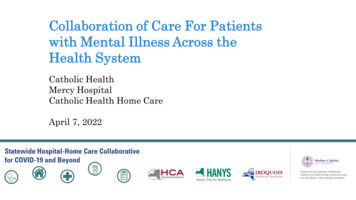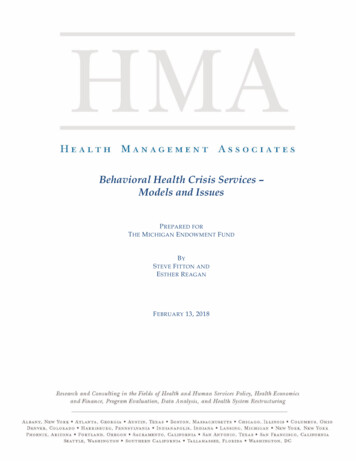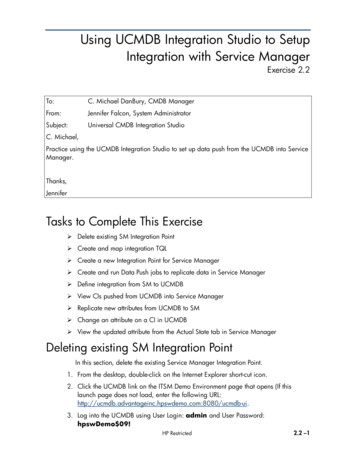
Transcription
CHAPTER 4Integration ofBehavioral andPhysical HealthServices in Medicaid
Chapter 4: Integration of Behavioral and Physical Health Services in MedicaidIntegration of Behavioral and PhysicalHealth Services in MedicaidKey Points 76Services for physical health and behavioral health (which includes mental health andsubstance use disorders) historically have been financed and delivered under separatesystems. As a result, Medicaid enrollees with behavioral health conditions often findthemselves interacting with multiple public and private agencies and receiving care frommyriad providers funded from different sources.Given the large numbers of Medicaid beneficiaries with a behavioral health diagnosis and thesubstantial costs associated with their care, state Medicaid programs are looking for ways toimprove care and reduce expenses. Clinicians and program administrators are also looking forbetter ways to treat behavioral health conditions and prevent these conditions from gettingworse or contributing to a decline in physical health.Integrating physical and behavioral health has been shown to reduce fragmentation ofservices and promote patient-centered care for adults with depression and anxiety disorders.However, current evidence is limited or inconclusive for children and adolescents and forindividuals with substance use disorders or serious mental illness. The growing number ofbehavioral health integration evaluations underway will provide additional information on howthese efforts are affecting outcomes and costs.There is no one-size-fits-all model for behavioral health integration. Efforts to integrate carecan encompass clinical, financial, and administrative domains. State Medicaid programsare adopting different approaches to integrate behavioral health and physical health care,including comprehensive managed care, health homes, and accountable care organizations.Legal, administrative, and cultural barriers can discourage integration efforts. These barriersinclude billing restrictions, privacy requirements and data sharing restrictions, the Medicaidinstitutions for mental diseases (IMD) exclusion, and separate professional training ofphysical health and behavioral health providers.The Commission plans to explore approaches to integrating additional services, such aspharmacy, long-term services and supports, and social determinants of health. We alsointend to examine the impact of the Medicaid IMD exclusion on behavioral health servicesand Medicaid’s interaction with other systems that provide behavioral health services to theMedicaid population, such as the criminal justice system.March 2016
Chapter 4: Integration of Behavioral and Physical Health Services in MedicaidCHAPTER 4:Integration of Behavioraland Physical HealthServices in MedicaidHistorically, services for physical health andbehavioral health (which includes both mentalhealth and substance use disorders) have beenfinanced and delivered under separate systems.That means Medicaid enrollees with behavioralhealth conditions often find themselves interactingwith multiple public and private agencies andreceiving care from myriad providers funded fromdifferent sources. This fragmentation can impedeaccess to care and result in inappropriate use ofservices, poor health status, and increased costs(Melek et al. 2014, IOM 2006, deGruy 1996). Aspolicymakers, program administrators, clinicians,and patient advocates consider ways to improvethe delivery of services for individuals withbehavioral health disorders, some are pointingto integration of the delivery of behavioral andphysical health services as critical to bothproviding care more cost effectively and improvinghealth outcomes.The term behavioral health integration is usedto describe a wide range of activities designedto provide care to the whole person (includingphysical health, behavioral health, and otherservices) in contrast to approaches that focus onspecific body systems, diagnoses, or conditions.Efforts to integrate behavioral and physicalhealth extend across the continuum of care,from prevention to rehabilitation. These effortsinclude colocating physical and behavioral healthproviders, sharing data and information, blendingfunding streams, and consolidating Medicaid andstate behavioral health agencies. The Agencyfor Healthcare Research and Quality (AHRQ), inits Lexicon for Behavioral Health and Primary CareIntegration, defines integration as “the care thatresults from a practice team of primary care andReport to Congress on Medicaid and CHIPbehavioral health clinicians, working together withpatients and families, using a systematic and costeffective approach to provide patient-centered carefor a defined population. This care may addressmental health and substance abuse conditions,health behaviors (including their contribution tochronic medical illnesses), life stressors and crises,stress-related physical symptoms, and ineffectivepatterns of health care utilization” (Peek andNIAC 2013). This broad definition can be used tocharacterize the many different approaches thatclinical providers and state Medicaid programshave used to implement integration, which canoccur across varying levels (e.g., clinical, payment,and administrative).There is a burgeoning evidence base that suggestsintegration efforts can lead to improved careand reduced costs when focused on certainpopulations or certain circumstances. For example,randomized control trials, systematic literaturereviews, and meta-analyses have documented theeffectiveness of integrating behavioral health intoprimary care settings for adults with depressionand anxiety disorders (Miller et al. 2013, Archer etal. 2012, Woltmann et al. 2012). The evidence basesupporting integration models for individuals withsubstance use disorders or serious mental illness,however, is limited and has shown mixed results(Asarnow et al. 2015, Gerrity 2014). Additionally,there are relatively few studies examining theeffect of integration models on outcomes forchildren and adolescents (Asarnow et al. 2015).Furthermore, most studies have focused onclinical integration at the practice level, leavingmany questions unanswered about the effects offinancial and administrative integration efforts thatare underway in Medicaid programs.There is no one-size-fits-all model for behavioraland physical health integration due to the variationin recommended treatment and treatment locationfor different behavioral health conditions. TheNational Council for Community BehavioralHealthcare’s Four Quadrant Model suggests thatindividuals who are at the lowest risk for behavioral77
Chapter 4: Integration of Behavioral and Physical Health Services in Medicaidand physical complications are best served in aphysical health setting with on-site behavioralhealth clinicians. Individuals with high behavioralhealth needs and low physical needs might bebetter served in behavioral health settings thathave linkages to physical care. Those with highphysical and high behavioral health needs maybenefit most from bidirectional models of care, inwhich the individual is served in both health caresettings with close collaboration between the twosites (Mauer 2009).The integration of behavioral and physical healthshould not be viewed as a panacea. Breakingdown silos in the payment and administration ofbehavioral health does not ensure that individualswith behavioral health disorders will receiveappropriate services in the most cost-effectivemanner. Moreover, compared to physical health,there are fewer performance measures forbehavioral health and fewer proven strategies forimplementing measures that do exist to improvequality and outcomes (Barry et al. 2015, Kilbourneet al. 2010). Such knowledge gaps make it difficultto evaluate the effectiveness of interventions,generalize about the benefits of integration, anddetermine which integration elements can lead toimproved health care outcomes or cost savings.Even so, state Medicaid programs are increasinglyadopting varying degrees of behavioral healthintegration to address the needs of the 20percent of Medicaid beneficiaries with behavioralhealth disorders (MACPAC 2015a, SHADAC2015). Federal efforts, such as the Centers forMedicare & Medicaid Services (CMS) MedicaidInnovation Accelerator Program, are encouragingstate integration initiatives by providing programsupport and funding to states to improve orexpand their current mental and physical healthintegration efforts (CMS 2015a). These effortstake different approaches and focus on differentlevels of integration—clinical, payment, andadministrative. However, the ability to implementspecific integration strategies may be affected bystate and federal policies as well as the structure78of clinical practice. Medicaid programs are workingwith partners to overcome some of these barriers.In addition, the 114th Congress is consideringlegislation to address known barriers to integrationefforts—including policies about data sharing andsame-day billing for physical and behavioral healthservices—and to provide incentives for mentalhealth professionals to adopt electronic healthrecords.This chapter builds on the Commission’s earlierwork documenting the compelling need to findmore cost-effective ways to treat individualswith behavioral health conditions—compellingbecause of the number of Medicaid beneficiariesin need of care and their share of total Medicaidexpenditures. These individuals comprise a diversegroup, ranging from young children who needscreening, referral, and treatment for attentiondeficit hyperactivity disorder or depression tochronically homeless adults with serious mentalillness (MACPAC 2015a).In this chapter, we provide an overview of thedifferent ways that behavioral health can beintegrated at the clinical, payer, and administrativelevels within Medicaid programs. Our reviewof recently implemented models includescomprehensive managed care arrangements, healthhomes, and accountable care organizations (ACOs)(SHADAC 2015). We do not draw conclusionsabout which models of physical and behavioralintegration are most effective. Rather, we discussthe factors that impede behavioral and physicalhealth integration at both the practice and theprogram levels, such as billing and data sharingrestrictions, variation in covered services, andlicensing requirements—areas the Commission willinvestigate more fully in future work analyzing howbehavioral health services are delivered in Medicaid.March 2016
Chapter 4: Integration of Behavioral and Physical Health Services in MedicaidWhy Focus on IntegratingBehavioral and PhysicalHealth in Medicaid?Integrating physical and behavioral health is oneapproach that states and the federal governmentare turning to in order to improve care and reduceexpenses for high-cost, high-need beneficiaries.Clinicians and program administrators arelooking for better ways to treat behavioralhealth conditions and better ways to preventbehavioral health conditions from getting worse orcontributing to a decline in physical health.As noted in the Commission’s June 2015 report toCongress, Medicaid is the single largest payer inthe United States for behavioral health services,accounting for 26 percent of such expenditures in2009. In 2011, one in five Medicaid beneficiarieshad a behavioral health diagnosis, but care forthese individuals accounted for almost half oftotal Medicaid expenditures. Certain Medicaideligibility groups have the highest prevalence of,and expenditures for, behavioral health services.For example, in 2011, almost half of non-duallyeligible adults enrolled in Medicaid on the basisof a disability had a behavioral health diagnosis.Similarly, the 44 percent of children eligible onthe basis of receiving child welfare assistancewho had behavioral health diagnoses accountedfor 78 percent of total expenditures for thiseligibility group. Enrollees with a behavioral healthdiagnosis have higher total expenditures than theircounterparts with no behavioral health diagnosis inevery eligibility group examined. Furthermore, manypeople with serious behavioral health disordershave a substantial number of comorbid acute orchronic medical conditions (MACPAC 2015a).Hundreds of collaborative and integrated careinitiatives are now underway, as evidenced bythe growing number of new clinical practicemanuals and websites offering information onhow to integrate behavioral health and medicalcare as well as the development of new businessReport to Congress on Medicaid and CHIPventures to help providers integrate care (Miller etal. 2014a). State Medicaid programs that contractwith managed care organizations are increasinglymoving toward carve-in models, meaning thatbehavioral health services are covered along withphysical health services under a managed carebenefit package, capitation rate, and network,rather than being covered separately. At leastseven states (Alabama, Colorado, Iowa, Louisiana,Nebraska, New York, and Washington) are currentlyplanning to end their Medicaid behavioral healthcarve outs (OpenMinds 2016). There also ismovement within Medicaid programs to use healthhomes and ACO models to integrate the deliveryof physical and behavioral health services(SHADAC 2015).While there is general agreement amongresearchers, advocates, and clinicians thatthe integration of physical and behavioral canimprove health outcomes and reduce spending,the research supporting this belief is inconclusiveand does not support one model of integration asbeing superior to others. The majority of researchexamining behavioral and physical integration hasdocumented the effectiveness of collaborativecare and integration for adults with depression andanxiety disorders (Archer et al. 2012, Woltmannet al. 2012, Miller et al. 2013). Results from theseevaluations suggest that collaborative modelsdemonstrate improvements in depression andanxiety, mental and physical quality of life,medication use, and social role function. However,in practice, clinical settings have a unique set ofpatients with different severities of behavioralhealth disorders resulting in different approachesto integration. Given the diversity of patientpopulations and approaches to integration, nosingle element has emerged as essential to thesuccess of the model, and researchers have notbeen able to identify specific populations, settings,or trial implementation factors associated withbetter or worse performance of the integrationmodel (Miller et al. 2013, Woltmann et al. 2012).79
Chapter 4: Integration of Behavioral and Physical Health Services in MedicaidThere are fewer studies that examine the effectof collaborative care and integration models onimproving health care outcomes for children andadolescents with behavioral health disorders(Asarnow et al. 2015). Available research suggeststhat integrating behavioral health care withinprimary medical care for children and adolescentswith depression, anxiety, or behavioral disorderscan improve behavioral health outcomes; however,the benefits of integrating medical and behavioralhealth have not been shown to be statisticallysignificant for children and adolescents withsubstance use disorders (Asarnow et al. 2015,Kolko et al. 2014).In general, published research has not focused onexamining the effects of integration on individualswith serious mental illness or substance usedisorders. One literature review suggests that theapproaches of fully integrating care and enhancingcollaboration through care management bothappear to improve mental health outcomes for anduse of preventive services by adult patients withserious mental illness (Gerrity 2014). However,colocating primary care in chemical-dependencytreatment settings without further integration ofservices or collaboration between providers mayhave little impact on outcomes for individualswith substance use disorders (Gerrity 2014).Programs focusing on integrating behavioral andphysical health for individuals with serious mentalillness have produced improvements in control ofdiabetes, cholesterol, and hypertension, but havenot shown improvements in obesity or smoking,and have not suggested a clear connectionbetween integrated care and most behavioralhealth outcomes (Scharf et al. 2014).Of note, none of the above studies explicitlydiscusses how or if Medicaid beneficiaries wereincluded in the study populations. However, asMedicaid programs begin implementing behavioralhealth integration initiatives, case studies aresurfacing that highlight the effects of theseprograms. For example, Hennepin Health, an ACOin Minnesota that was created specifically to serve80adults newly covered under the state’s Medicaidexpansion, has assembled multidisciplinarycare teams, initiated data sharing throughunified electronic health records, and embeddedbehavioral health providers in primary care settingsto integrate behavioral and physical health. Theprogram has documented decreases in emergencyroom and inpatient admissions and increasesin outpatient visits and the number of patientsreceiving optimal diabetes, vascular, and asthmacare (Sandberg et al. 2014).There are a limited but growing number of casestudies that specifically examine Medicaidintegration initiatives and their effects on costs.1For example, Missouri’s Community Mental HealthCenter Health Homes initiative, which is designedto provide integrated, patient-centered care toMedicaid beneficiaries with serious mental illnessand those with other behavioral health problemscombined with certain chronic conditions ortobacco use, decreased costs by 7.4 million after18 months (Parks 2014). More information on theeffects of behavioral health integration on coststo Medicaid will become available through anindependent, five-year evaluation of the new healthhome model that was authorized under Section2703 of the Patient Protection and AffordableCare Act (ACA, P.L. 111-148, as amended) and aslongitudinal data from other initiatives becomeavailable (Spillman et al. 2014).Research suggests that integrating physicaland behavioral health can reduce fragmentationof services and promote patient-centered care.However, integrating care is complex and thesuccess of the endeavor will depend on variablessuch as population characteristics, geography,market infrastructure, and types of behavioralhealth services delivered. We explore physical andbehavioral health integration efforts, especiallythose being implemented within the context of theMedicaid program, in the following sections.March 2016
Chapter 4: Integration of Behavioral and Physical Health Services in MedicaidLevels of Integration inMedicaidIntegration of behavioral and physical health canoccur at different levels. Clinical integration occursat the point of service and refers to the actionsclinicians and care coordinators take to bridge thedivide between the physical and behavioral healthdelivery systems and provide person-centered care.System integration occurs at the program policyand administration level and includes actionspayers and administrators of behavioral healthservices take, such as blending funding streamsand consolidating the administration of services.Clinical integrationPhysical and behavioral health providers typicallypractice in separate facilities and have differentphilosophies and training on how best to treatpatients. (A divide can exist even among behavioralhealth providers; for example, mental healthand substance use services are often providedin separate settings, by different providers, withdiverse expertise.) Separate systems for physicaland behavioral health can result in beneficiarieswith comorbid conditions bouncing between caresettings. Such fragmentation can be confusingfor patients to navigate and confusing forproviders who are unaware of treatment plans orprescriptions recommended by other professionals.It can result in inappropriate, uncoordinated, andoften inefficient care and lead to poor healthoutcomes and increased costs (IOM 2006).Behavioral health conditions are often firstdiagnosed and treated in a primary care settingor in the emergency room (Anderson et al. 2015,Kessler 2012, Downey et al. 2009, Kessler andStafford 2008). This reliance on primary carediagnosis for behavioral health conditions mayreflect the high prevalence of comorbid physicalconditions, limited access to behavioral healthproviders, or the prevailing stigma associatedwith seeking and receiving behavioral healthReport to Congress on Medicaid and CHIPtreatment (MACPAC 2015a, Klein and Hostetter2014). Complicating matters, physical healthproviders may not be trained to diagnose or treatbehavioral health conditions or make referrals toappropriate clinicians, and as a result, individualswith behavioral health conditions may leave ahealth care setting without receiving appropriatetreatment or referrals (Klein and Hostetter 2014).Clinical integration can occur in three ways—bringing physical health care into traditionalbehavioral health settings, bringing behavioralhealth care into traditional physical health settings,or doing both. At its best, clinical integration canchange the focus of care delivery from isolatedepisodes of treatment to a comprehensiveapproach in which services are delivered ina consistent and coordinated manner withaccountability not only for health outcomes butalso for costs (Cohen et al. 2015). Integratingphysical and behavioral health services canpromote patient referrals and follow-up, fostercollaboration in decision making, and connectbeneficiaries to needed resources, resulting in moreeffective and efficient care (Heath et al. 2013, Peekand NIAC 2013, Brown et al. 2012).Although there is no one model of clinicalintegration or definitive set of core features thatwill always lead to improved health outcomes andreduced costs, components of integration at theclinical level can include the following:Care coordination/care management. Carecoordinators (also referred to as care managers)act as single points of contact for patients and ashubs for the multiple providers treating a patient.They can facilitate the appropriate delivery ofbehavioral and physical health services to patientsby assessing patient needs and goals, creatingcare plans, helping the patient transition from aninstitutional setting to the community, followingup after appointments, monitoring compliancewith doctors’ orders, supporting the patient’sself-management goals, and linking patients tocommunity resources (Nardone et al. 2014, Heath81
Chapter 4: Integration of Behavioral and Physical Health Services in Medicaidet al. 2013, Peek and NIAC 2013, IOM 2006). Carecoordinators can be located in behavioral health,physical health, or other settings, for instance,within the state or local Medicaid program office.Colocation. Colocation refers to physically locatingbehavioral health and physical health providersin the same facility (Miller et al. 2014b). For theMedicaid population, colocation can decreaseout-of-pocket costs, such as transportation andchild care associated with making trips to multiplelocations, and encourage follow-up with referredproviders (Nardone et al. 2014). For providers,colocation can encourage face-to-face contactbetween providers; foster communication aboutshared patients; improve the efficiency of servicesthough sharing intake, billing, and administrativeservices; and enhance quality through a teambased approach to care (Heath et al. 2013).Data sharing. Sharing clinical and other patientinformation can help care managers and providersfrom different disciplines communicate andcoordinate care (Cifuentes et al. 2015). Electronichealth records can give authorized individualsimmediate access to patient data and supportknowledge transfer and informed decision makingamong providers (Cifuentes et al. 2015, Peek andNIAC 2013, IOM 2006). The state of Michigan,for example, developed the Michigan HealthInformation Network Shared Services systemto share electronic health information betweenhealth care providers, Michigan’s health insuranceexchange, CMS, Department of Veterans’ Affairs,and the Social Security Administration (MiHIN2015). The system connects networks of providersfocused on physical health with behavioral healthand substance abuse treatment organizations,allowing providers to share a range of patientdata, including demographics, type of insurancecoverage, hospital admissions, medications, labresults, diagnoses, allergies, treatment plans,clinical documentation, appointments, careteam information, and activity logs (MiHIN 2015,SAMHSA-HRSA 2015).82Formal or informal agreements with externalpartners. Formal and informal arrangementsbetween providers of behavioral health, physicalhealth, or auxiliary services (e.g., transportation,housing) can ensure beneficiary access to a fullcomplement of services. For example, a substanceuse treatment center or mental health organizationmight contract with a medical group to providephysical examinations and routine medical carefor its patients, or health care providers mightcreate referral relationships with communitypartners providing transportation services. Sucharrangements would allow providers to usecommunity resources without colocating services,which can be difficult and costly to implement.Screening and referral to treatment. Screening andreferral to treatment refers to a comprehensiveand integrated approach to identifying appropriatetreatments and preventive care and recommendingthe appropriate source of care for identifiedtreatments (Kessler et al. 2014). Screening andreferrals can occur in both physical health andbehavioral health settings. For example, physicalhealth providers can use tools to identify specificbehavioral health conditions and then help the patienttake steps to get additional treatment. Conversely,behavioral health providers can be trained to monitorbasic physical health conditions (Nardone et al. 2014).An evidence-based method called Screening, BriefIntervention, and Referral to Treatment (SBIRT) canbe used to identify, reduce, and prevent problematicuse of alcohol and illicit drugs (SBIRT Colorado2011). Providers can use SBIRT to assess patientsfor risky behaviors, engage patients who exhibit riskybehaviors, and make referrals to additional treatmentas needed. It also helps providers and patientsunderstand the potential health consequencesof substance abuse and take steps to reducerisky behaviors. SBIRT has been shown to reduceemergency room usage and health care costs(SBIRT Colorado 2011). SBIRT is covered by someMedicaid programs (CMS 2014a); it is used by otherprograms, such as coordinated care organizationsin Oregon, as a benchmark and improvementmeasure (Oregon Health Authority 2015).March 2016
Chapter 4: Integration of Behavioral and Physical Health Services in MedicaidProvider education and training. Introducingconcepts of behavioral health, interdisciplinarycare teams, and integration to provider educationand training programs can influence the futurehealth care workforce’s expertise and expectationsabout clinical practice (Box 4-1). Residency trainingin family medicine and psychiatry is evolvingto address these barriers to integration. Familymedicine residents are now required to receivetraining in behavioral health, and psychiatryresidents are required to complete a portion of thefirst year of residency training in a primary caresetting (ACGME 2014a, 2014b). However, suchtraining is not required in other medical specialties(ACGME 2013, Leigh et al. 2008).Clinical integration of behavioral and physicalhealth is being implemented at the federal andthe state level. At the federal level, the ProtectingAccess to Medicare Act of 2014 (P.L. 113-93)authorized a demonstration of a new providertype: certified community behavioral healthclinics. These clinics are designed to providecommunity-based behavioral health services andare required to support care coordination, partnerwith other state and federal agencies deliveringbehavioral health services, hire staff with diversedisciplinary backgrounds, and develop formalrelationships with other providers to ensureappropriate referrals and delivery of necessarytreatment. Certified clinics are eligible for enhancedMedicaid funding through a prospective paymentsystem that supports the delivery of evidencebased and integrated care. Additionally, statescan receive an enhanced Medicaid federal matchfor services delivered by certified communitybehavioral health clinics (SAMHSA 2015a). As ofOctober 2015, 24 states received planning grantsto support the development of the demonstration.After the planning grant ends, up to eight stateswill be eligible to participate in the demonstration(SAMHSA 2015b).BOX 4-1. P roject TEACH (Training and Education for the Advancement ofChildren’s Health)In 2007, New York State created Project TEACH as a way to strengthen and support the ability ofprimary care physicians to provide mental health services to children, adolescents, and families.Project TEACH provides primary care providers with 15 hours of in-person training over 3 days,a 6-month case-based clinical distance learning program (including 12 hour-long consultationcalls), and a set of web-based learning tools. Project TEACH has two component programs: Childand Adolescent Psychiatry for Primary Care and Child and Adolescent Psychiatry Education andSupport. Both component programs provide primary care providers with training, education, andassistance as well as information about specialized mental health centers located in their practiceregion (IDEAS Center 2015).An evaluation of the programs found that participating primary care providers reported moreconfidence interacting with families, assessing the severity of behavioral health conditions,prescribing medication, and developing treatment plans for children and adolescents with mentalhealth conditions. Providers also reported better interactions with mental health specialists. Therewere, however, reports of barriers to implementin
services) in contrast to approaches that focus on specific body systems, diagnoses, or conditions. Efforts to integrate behavioral and physical health extend across the continuum of care, from prevention to rehabilitation. These efforts include colocating physical and behavioral health providers, sharing data and information, blending










